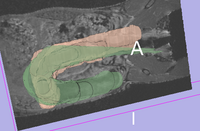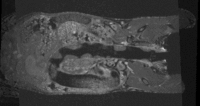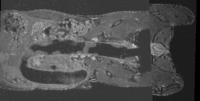Difference between revisions of "Projects:RegistrationLibrary:RegLib C35"
From NAMIC Wiki
| Line 34: | Line 34: | ||
===Registration Challenges=== | ===Registration Challenges=== | ||
*The image content to be registered is less than 10% of the total image and of low energy (close to background); | *The image content to be registered is less than 10% of the total image and of low energy (close to background); | ||
| − | [[Image: | + | [[Image:RegLib_C35_Histogram.png|150px|lleft|histogram of image content: target structure (colon, red) is very small amount of total image energy, making intensity-based automated approach unlikely to succeed]] |
*there's large portions of the colon for which no matching/corresponding structures exist, i.e. a straightforward one-one mapping is not avail. | *there's large portions of the colon for which no matching/corresponding structures exist, i.e. a straightforward one-one mapping is not avail. | ||
*other landmarks (kidneys etc.) are very different in position and size | *other landmarks (kidneys etc.) are very different in position and size | ||
Revision as of 16:13, 1 March 2011
Home < Projects:RegistrationLibrary:RegLib C35Back to ARRA main page
Back to Registration main page
Back to Registration Use-case Inventory
Contents
v3.6.1  Slicer Registration Library Case #35: Mouse Colon Brain MRI
Slicer Registration Library Case #35: Mouse Colon Brain MRI
Input

|

|

|
| fixed image 1/target MRI mouse 1 |
moving image MRI mouse 2 |
Modules
- Slicer 3.6.1 recommended modules: SurfaceRegistration, Transforms (manual registration), Fast Marching Segmentation, Histogram Matching, Model Maker,
Objective / Background
Aim is to register the two MRIs such that the colon aligns.
Download
- DATA
- See detailed pipeline with parameter settings below
Keywords
MRI, colon, mouse, masking, non-human, non-rigid,manual, unsolved
Input Data
- reference/fixed MRI: 0.12 x 0.12 x 0.1 mm, 512 x 512 x 94
- moving MRI: 0.09 x 0.09 x 0.1 mm, 512 x 512 x 94
Registration Challenges
- The image content to be registered is less than 10% of the total image and of low energy (close to background);
- there's large portions of the colon for which no matching/corresponding structures exist, i.e. a straightforward one-one mapping is not avail.
- other landmarks (kidneys etc.) are very different in position and size
Key Strategies
- This is a challenge case and currently unsolved. Best hopes are combinations of manual, fiducial and surface-based registration
- Slicer 3.6.1 recommended modules:
- Surface Registration
- Plastimatch
Registration Results
 very rough surface models of colon help visualize misalignment
very rough surface models of colon help visualize misalignment
 original, not registered
original, not registered
 after surface registration (rigid) + manual correction
after surface registration (rigid) + manual correction
